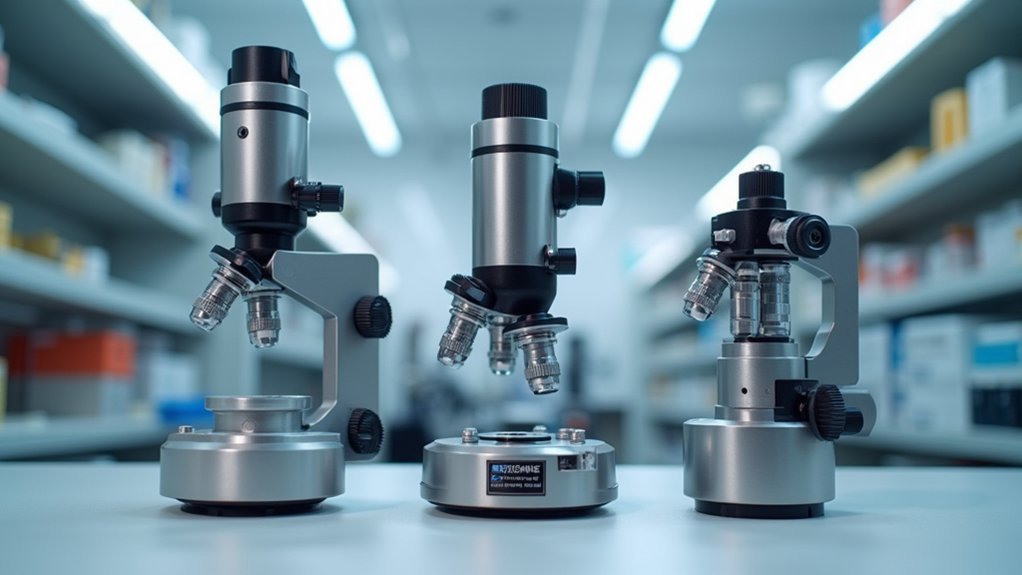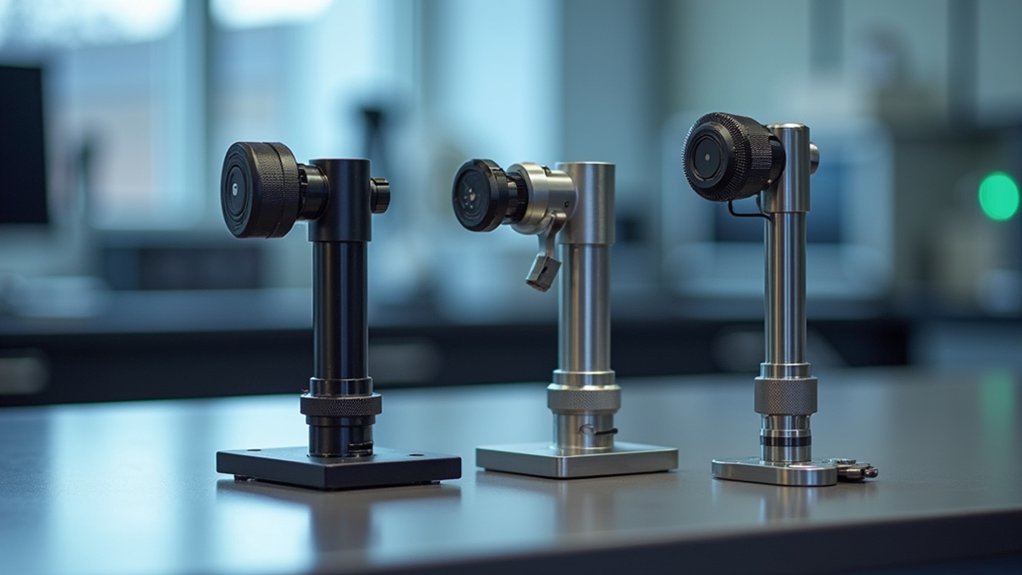Top stage stabilizers for shake-free sample imaging include piezoelectric systems for sub-micron precision, active stabilization mechanisms that counteract environmental disturbances in real-time, and physical vibration isolation platforms with multi-layer construction. You’ll find these technologies essential for maintaining focus integrity and measurement accuracy during sensitive imaging work. Each solution combines sophisticated hardware with advanced software to eliminate camera shake and preserve image quality. Discover how these systems can transform your research results.
Comparing Microscope Stage Stabilization Technologies for Enhanced Imaging

While traditional microscopy often struggles with stability issues, modern stage stabilization technologies have revolutionized sample imaging by virtually eliminating unwanted movement and vibration.
You’ll find three primary approaches dominating today’s market: piezoelectric systems delivering sub-micron level precision, active stabilization mechanisms that dynamically counteract environmental disturbances in real-time, and physical vibration isolation systems that decouple your stage from external forces.
Modern stabilization systems combine piezoelectric precision, active environmental compensation, and physical isolation to achieve unparalleled imaging accuracy.
The most advanced options integrate digital image processing algorithms that filter out motion artifacts, considerably improving signal-to-noise ratios.
This combination of hardware and software solutions effectively eliminates camera shake, ensuring consistent imaging conditions regardless of your laboratory environment.
For researchers requiring enhanced imaging of sensitive samples like live cells, these technologies maintain focus integrity and measurement accuracy that would otherwise be compromised by even minor vibrations.
Key Features of Premium Anti-Vibration Platforms for Microscopy
Stability excellence defines premium anti-vibration platforms, offering microscopists the foundation needed for flawless high-resolution imaging. When you’re working with sensitive samples, these platforms eliminate external disturbances that would otherwise compromise your results.
- Multi-layer construction – Premium platforms utilize materials like granite or aluminum that naturally dampen vibrations, while sophisticated damping systems absorb shock and prevent resonance for precise imaging results.
- Adaptable configuration – Look for adjustable leveling feet that guarantee perfect horizontal alignment regardless of floor imperfections, alongside vibration isolation systems that neutralize disruptions from nearby equipment.
- Versatile integration – The best platforms feature modular design and customizable dimensions, accommodating various microscope models and laboratory setups while maintaining the stability essential for consistent imaging quality.
Performance Analysis of Leading Stage Stabilizers in Scientific Photography

When analyzing the performance of leading stage stabilizers, researchers must consider both technical specifications and real-world applications in scientific photography.
You’ll find that Tiffen Steadicam offers advanced stabilization features that eliminate camera shakes during critical sample imaging sessions.
The DJI Ronin M’s 3-axis gimbals provide automatic adjustments that you’ll appreciate when working in dynamic scientific environments.
Intelligent 3-axis stabilization delivers seamless adaptability for demanding scientific imaging scenarios.
They’ve integrated electronic stabilization systems that deliver real-time feedback, essential for precise scientific imaging.
Don’t overlook proper balancing techniques when using handheld stabilizers—they’re directly responsible for footage quality and data reliability.
The best stabilizers offer customizable weight ratings to accommodate your specific camera setup without compromising stability.
This versatility guarantees shake-free imaging across various scientific applications, from microscopy to field research.
Frequently Asked Questions
How Do You Stabilize Shaky Videos for Free?
You can stabilize shaky videos for free using iMovie on macOS, Windows Movie Maker, Google Photos for Android, or online tools like Stabilizo and Kapwing. These options offer simple electronic stabilization features without cost.
What Is the Best Warp Stabilizer Software?
Adobe Premiere Pro offers the best warp stabilizer software with powerful smooth motion and no motion options. You’ll get professional results, though free alternatives like iMovie or Google Photos can help if you’re on a budget.
Which Is the Best Video Stabilizer?
The best video stabilizer depends on your needs. For professionals, the DJI Ronin M offers advanced motorized stabilization. If you’re budget-conscious, try the Yelangu S60T CF. The Glidecam HD-Pro provides battery-free versatility.
How to Stabilize Video Without Losing Quality?
To stabilize video without losing quality, you’ll want to use advanced editing software with non-destructive stabilization algorithms, enable GPU acceleration, choose high-resolution output formats, and adjust correction levels to maintain your footage’s original integrity.
In Summary
You’ve now explored the top three stage stabilizers that can transform your microscopy experience. Whether you’re conducting research or capturing detailed images, these anti-vibration systems will eliminate unwanted movement and enhance your results. Remember, the right stabilizer depends on your specific application, budget, and space considerations. Don’t compromise on stability—it’s the foundation of accurate, reproducible imaging in any scientific setting.





Leave a Reply